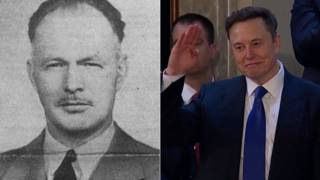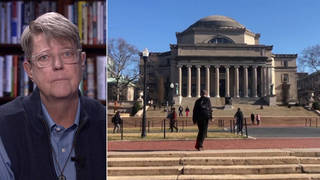
Links
In Mexico, the government has released 42 protesters two weeks after they were rounded up during a demonstration in Oaxaca. Many of those released say they were beaten in jail and describe abuse at the hands of police. Democracy Now! producer Elizabeth Press and John Gibler, journalist and Global Exchange human rights fellow, file a report from the streets of Oaxaca. [includes rush transcript]
Transcript
AMY GOODMAN: We begin today in Oaxaca, Mexico, where the government has released 42 protesters who were rounded up following a large demonstration two weeks ago. Demonstrators have been calling for the ouster of Oaxaca’s governor, Ulises Ruiz, and the withdrawal of federal police, who were sent there several weeks ago to crush the popular uprising by striking teachers and APPO, the Popular Assembly of the Peoples of Oaxaca.
Many of the newly released protesters have said that they were beaten in jail, and describe abuse at the hands of police. Scores of other protesters remain in jail, including Flavio Sosa, a leader of APPO. Sosa was arrested in Mexico City the day before he was to resume negotiations with the governor to resolve the conflict. Meanwhile, the federal police have begun withdrawing from the center of Oaxaca.
Democracy Now! producer Elizabeth Press is in Oaxaca with journalist and Global Exchange human rights fellow, John Gibler. They filed this report.
JOHN GIBLER: Beneath the fragile appearance of calm in Oaxaca City, both the struggle to force Governor Ulises Ruiz Ortiz from office and the dirty war waged against the protesters continue. There are no signs of the graffiti and protest camps of the Oaxaca People’s Popular Assembly, or APPO. In Oaxaca’s historic center, an occasional tourist can now be seen walking bewildered through the streets.
On Saturday, the federal preventive police force that occupied the town square, or Zocalo, on October 29 moved their troops and riot tanks out of the center to nearby bases, turning over control to the state police. Only one week before, the federal police had raided the state police headquarters, searching for illegal guns suspected of being used against protesters in a string of paramilitary-style attacks that took place between August and October, killing at least 15 people. On Saturday, for the first time since striking teachers and outraged citizens forced them out of town in a pitched street battle on June 14, those state police were back in charge.
The next day, some 2,000 women from the APPO marched through Oaxaca City, calling for the governor’s ouster and the immediate release of the more than 200 prisoners detained after confrontations with police on November 25. The women, who avoided confrontation with the state police, gathered at the Madero Park to greet the first prisoners to have been released. Two buses arrived after a 24-hour ride from the federal prison in Tepic, Nayarit, delivering 43 prisoners to the emotive greeting of the women and hundreds more APPO supporters and family members. This was the first contact of family and friends most of the prisoners had had since their detentions on November 25 and the first time people heard direct testimonies of their experience.
Ismael Estrada had been walking with his wife in central Oaxaca City, when he was attacked by federal police looking to round up APPO protesters.
ISMAEL ESTRADA: [translated] It was about 6:00 in the afternoon on the day of November 25, when the operation took place near Santa Domingo between Reforma and Cinco de Mayo Streets at the [inaudible]. We couldn’t do anything. About five or six of the federal preventive police attacked me and began to beat me with everything they had, kicking me and clubbing me with the police batons. Yes, here they split my head. I bled a lot. I was drenched in blood. In spite of that, they kept beating me.
JOHN GIBLER: Arbitrary detentions and forced disappearances have been used by both state and para-police forces since last August. These detentions increased dramatically after the federal police crackdown on protesters three weeks ago, but then dropped off again when the state police themselves became subject to a federal raid. Human rights workers continue to press the issue of forced disappearances as one of their gravest concerns. Yesica Sanchez of the Oaxaca office of the Mexican Human Rights Defense League has documented disappearances throughout the six-month conflict.
YESICA SANCHEZ: [translated] There is a moment when nobody knows where they are, when nobody knows why they have grabbed them and where they have taken them. This is completely terrifying, not only for the families, but for us, as well, because we don’t know if they can kill them, if they can torture them. The real fear is not the detention in itself, but the real fear is what happens in the space of darkness, where nobody knows if you can guarantee your life and safety.
JOHN GIBLER: After a short lull, plainclothes gunmen apprehended three APPO members on Monday, beating, interrogating and threatening to kill them. The gunmen identified themselves as being part of the death squad, referring to the state police convoys that wounded and killed protesters in August. Florentino Martinez, Pedro Garcia and Otalo Padilla, all members of the APPO and the Popular Revolutionary Front had left an APPO meeting at the teachers’ union headquarters when they were followed and detained by several cars and trucks carrying men with assault rifles and pistols. The gunmen ordered the APPO members into one of their vans, where they were beaten and tortured for over an hour.
APPO MEMBER: [translated] They were beating us throughout the trip. My friends were hit in the head. I could hear them screaming in pain. They were constantly stepping on our heads.
JOHN GIBLER: The gunmen threatened to shoot them and to fly them out over the sea and throw them from the plane. But after over an hour of beatings, they instead threw them out of the truck, keeping their possessions, including a laptop and USB memory stick with internal APPO documents. While freshly painted storefronts try to announce the return of calm to Oaxaca, the continued use of paramilitary-style violence against protesters speaks to the deep unrest that plagues the state, a violence that may end up pulling more people into the fold of the APPO than it scares away from the protests.
FMR. DETAINEE: [translated] The worst moment for me was the day they detained me. The tear gas, the police. They tied me up. I didn’t understand anything. I didn’t know what was happening. All 21 days were terrible. I didn’t know what the APPO was or the teachers’ union. I didn’t know anything about them. Now, I am determined to join them, because the government made me suffer so much. I’ll join them to help get rid of the government, because I don’t want this government anymore. They not only made me suffer, but also made my whole family suffer. I’ll work with the people who have been struggling, whatever the organization is, the APPO or whatever. I don’t want my grandchildren to suffer what I’ve suffered. I want to fight for the release of all the innocent women who are still in Nayarit. They are humble people who make fans to maintain their family. Some of them are barefoot. Many don’t even speak Spanish, only Mizteco.
JOHN GIBLER: For Democracy Now!, this is John Gibler reporting with Elizabeth Press in Oaxaca City.












Media Options